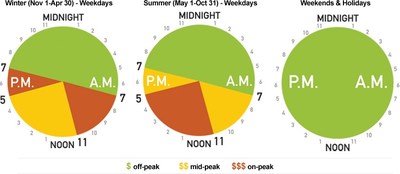|
26.10.2017 22:00:00
|
Time-of-use price periods for electricity users changing November 1
TORONTO, Oct. 26, 2017 /CNW/ - The Ontario Energy Board (OEB) is reminding households and small businesses that as of November 1, 2017, the time-of-use (TOU) price periods are changing, as is the threshold for residential customers that are paying tiered prices. TOU prices will not be changing.

The table below shows the winter Regulated Price Plan (RPP) prices that will be in effect during each TOU period from November 1, 2017 to April 30, 2018.
TOU price period | Winter hours | TOU prices effective
|
Off-Peak
| Weekdays from 7 p.m. – 7 a.m.
| 6.5 ¢/kWh |
Mid-Peak | Weekdays 11 a.m. – 5 p.m.
| 9.5 ¢/kWh |
On-Peak | Weekdays 7 a.m. – 11 a.m. and 5 p.m.
| 13.2 ¢/kWh |
The table below shows the same set of prices for RPP customers who pay tiered prices:
Price tiers | Tier threshold | Tiered prices effective
|
Tier 1 | Residential customers:
| 7.7 ¢/kWh |
Tier 2 | Residential customers: for Non-residential customers: | 9.0 ¢/kWh |
For customers that do not purchase their electricity from their utility, there will be no change to the Global Adjustment (GA) credit on November 1, 2017.
The OEB will reset RPP prices and the GA credit for April 30, 2018 in a way that holds increases to the rate of inflation in accordance with legislation.
About the Ontario Energy Board
The OEB is the independent regulator of Ontario's electricity and natural gas sectors. It makes decisions that serve the public interest. Its goal is to promote a sustainable and efficient energy sector that provides consumers with reliable energy services at a reasonable cost.
Backgrounder
Oct. 26, 2017
Time-of-use price periods shifting to winter season hours on November 1
TOU pricing
|
With time-of-use (TOU) prices, customers pay prices that generally reflect
There are three time-of-use periods – on-peak, mid-peak and off-peak.
TOU prices encourage households and small businesses to use
Nearly all residential customers and many small business customers on
|
Ratio
|
The off-peak price (6.5 ¢/kWh) is a little less than half the on-peak price
|
Why prices
|
TOU prices are set to be cheapest when demand is lowest: during the
In Ontario, when demand is lower, most of the electricity we use comes
As daytime begins, more people and businesses turn on their lights,
|
Summer |
TOU price periods are different in the summer than they are in the winter.
The difference reflects the seasonal variations in how customers
|
Tiered |
A small number of residential and small business customers are billed
The threshold for residential customers is 600 kWh/month in the summer,
|
Help for
|
Low-income consumers may be eligible for help paying their energy bills
|
Conservation
|
The Independent Electricity System Operator and utilities offer a variety of
|
Ce document est aussi disponible en français.

SOURCE Ontario Energy Board
 Der finanzen.at Ratgeber für Aktien!
Der finanzen.at Ratgeber für Aktien!
Wenn Sie mehr über das Thema Aktien erfahren wollen, finden Sie in unserem Ratgeber viele interessante Artikel dazu!
Jetzt informieren!
Nachrichten zu CanArgo Energy Corp.mehr Nachrichten
| Keine Nachrichten verfügbar. |
Analysen zu CanArgo Energy Corp.mehr Analysen
Aktien in diesem Artikel
| Canadian National Railway Co. | 100,60 | 1,31% |
|
| Manulife Financial Corp. | 28,97 | -0,82% |
|